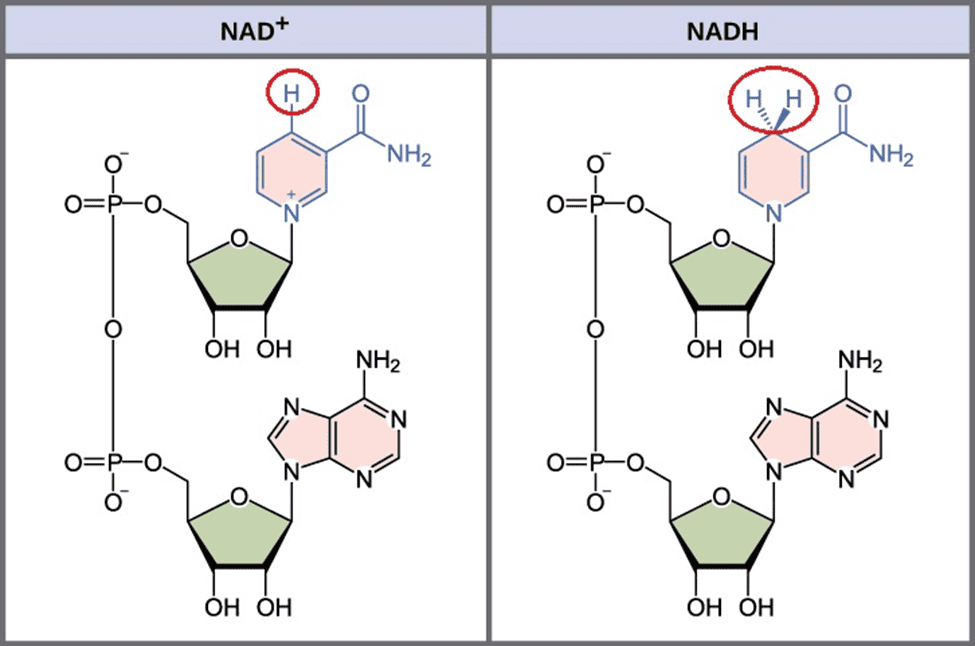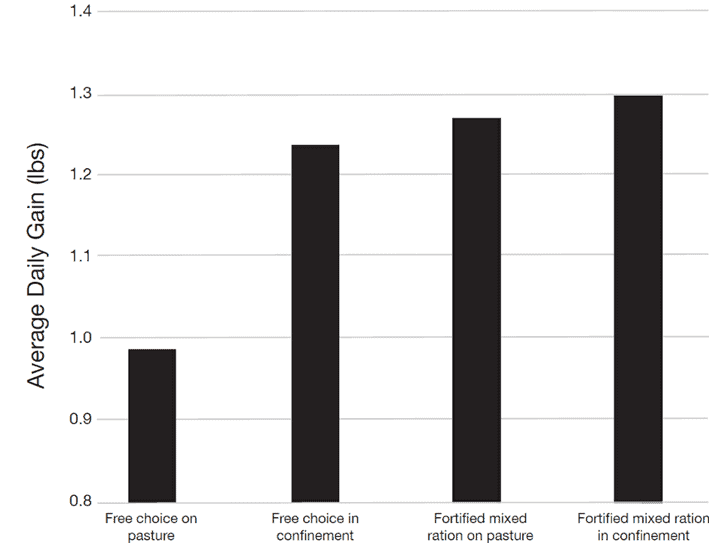Niacin, commonly known as Vitamin B3, is a powerhouse nutrient crucial for your body and mind’s optimal functioning.
It not only helps in converting the food you eat into energy but also plays a pivotal role in cell repair and fortifying your immune system against diseases. However, niacin deficiency is a widespread issue, with symptoms ranging from fatigue and skin disorders to severe conditions like dementia.
This comprehensive guide sheds light on the myriad benefits of niacin, the risks of deficiency, and how you can easily incorporate niacin-rich foods into your daily diet. With a blend of informative insights and tantalizing recipes, you’re on the right path to boosting your energy levels and enhancing your overall health.
This article will guide you through various B3 food sources to help you optimize your vitamin B3 intake. Dive in to explore the wonders of niacin and how you can make the most out of this essential nutrient.
- Best High Vitamin B3 Food Sources (Per Serving)
- Vitamin B3 (Niacin) Rich Food Sources (Per Calorie)
- Niacin Food Chart
- How Much Niacin (B3) Do You Need?
- Potential Risks of Excess Niacin Supplementation
- Niacin-Rich Recipes
- Why is Niacin Important?
- What Does Niacin Do in Your Body?
- You Can Make Niacin from Protein
- What Are the Symptoms of Vitamin B3 Deficiency?
- Niacin Storage in Your Body
- Functions of Niacin
- NAD+
- Factors That Increase Your Demand for Niacin
- Excess B3 Side Effects: The Niacin Flush
- Synergistic Nutrients with Niacin
- Niacin Fortification – A Double-Edged Sword?
- How Can I Calculate if I am Getting Enough Vitamin B3?
Best High Vitamin B3 Food Sources (Per Serving)
If you fall short of the recommended vitamin B3 intake, it’s time to focus on foods that pack in more niacin (B3) per serving. To help you get started, the infographic below shows the niacin provided by popular B3 food sources in the average serving sizes consumed by our Optimisers.
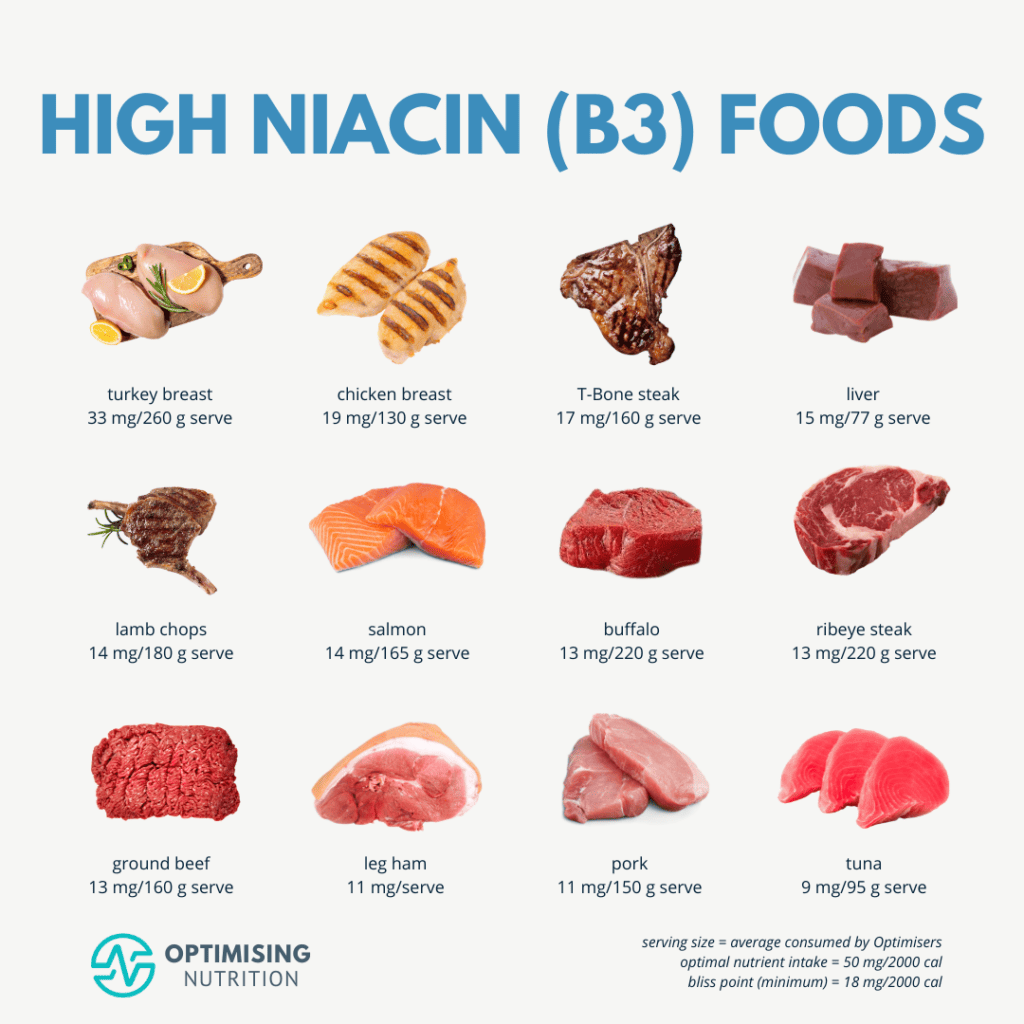
Once you’re ready to revitalise your diet with a wider variety of high-niacin foods, download our printable list of B3 food sources with more niacin per serving here.
Vitamin B3 (Niacin) Rich Food Sources (Per Calorie)
Once you know you’re getting the minimum amount of vitamin B3 your body needs, you can zero in on vitamin B3-rich foods that deliver more niacin per calorie to increase your satiety and nutrient density. The infographic below shows popular B3 food sources that provide more niacin per calorie. When you’re ready for more variety, check out our printable list of niacin-rich foods per calorie!
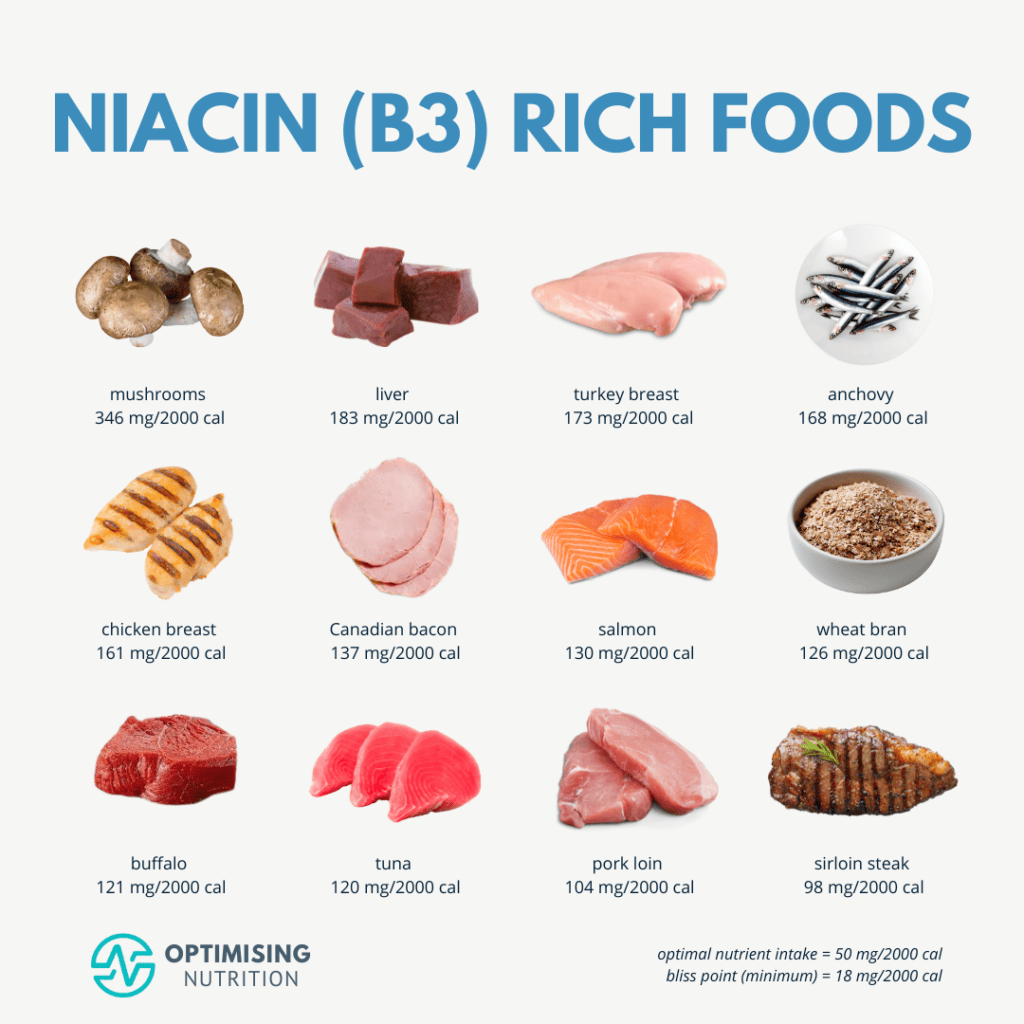
Niacin Food Chart
Curious about how your favourite foods stack up in the niacin game? Dive into our dynamic chart showcasing popular sources of vitamin B3, comparing niacin content per calorie and per serving. For an immersive experience, explore the interactive Tableau version (on your computer).
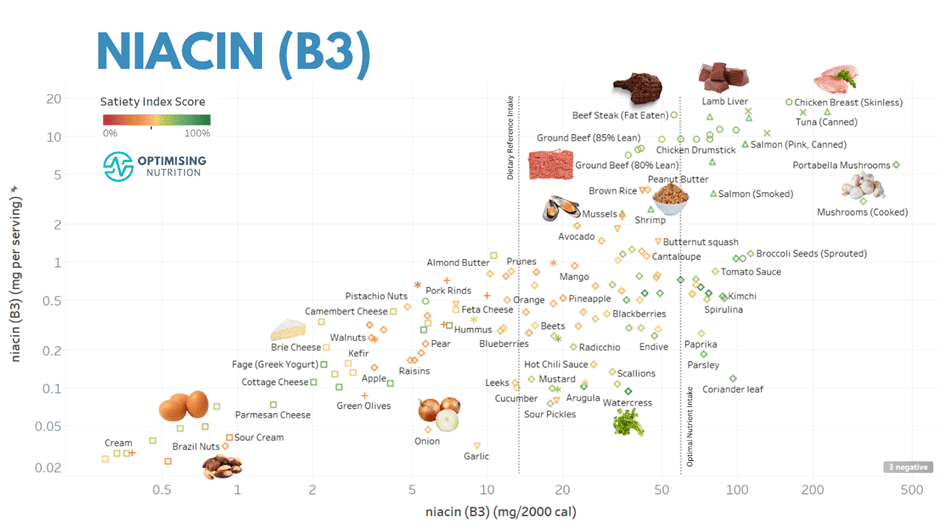
How Much Niacin (B3) Do You Need?
Our satiety analysis shows we crave at least 18 mg of vitamin B3 per 2000 calories, which is slightly more than the Dietary Reference Intake of 18 mg per day for men. Meanwhile, the Optimal Nutrient Intake of vitamin B3 is 50 mg/2000 calories from food, which aligns with a 26% reduction in energy intake.
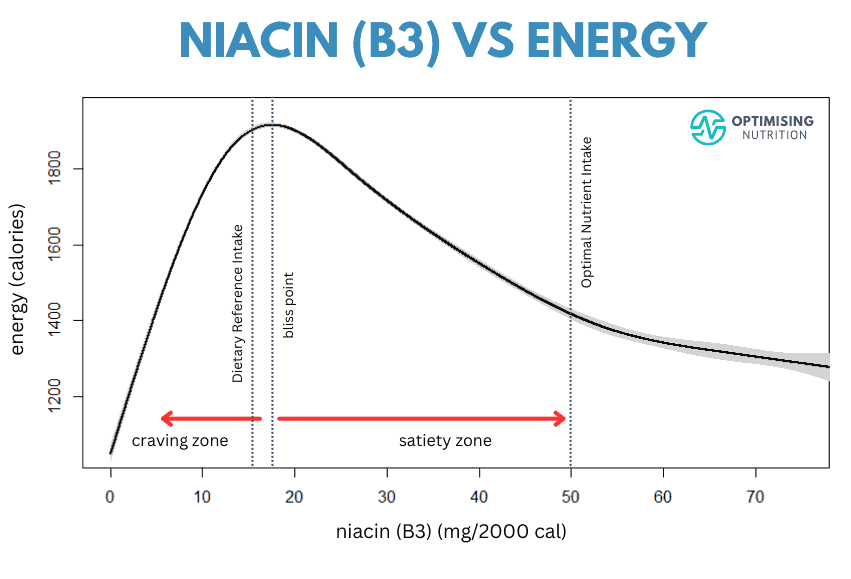
Potential Risks of Excess Niacin Supplementation
Niacin is one of the most readily absorbed vitamins. At high doses of 3 – 4 g per day, niacin is still taken into the bloodstream to create NAD+ and add to the circulating pool of niacin. This may be useful to replenish niacin stores if you’ve been fasting for extended periods, but supplementing more B3 does not always mean we produce more NAD+ or burn more energy. Excessively high supplemental intakes of niacin can contribute to peptic ulcers, hypotension, or liver damage.
It’s worth noting in the chart above that the satiety response starts to taper off at very high doses of niacin, which could only be achieved with supplementation and fortified foods. Hence, focusing on getting your niacin needs from food is best.
Niacin-Rich Recipes
Elevate your culinary game with our chart showcasing over 1400 NutriBooster recipes used in our Micros Masterclass. We’ve plotted these recipes based on vitamin B3 content versus protein percentage. The further right you go, the more vitamin B3 you can enjoy with fewer calories.

Dive into the details with our interactive Tableau chart on your computer. Click on each recipe to uncover the magic behind it and even feast your eyes on mouthwatering pictures!
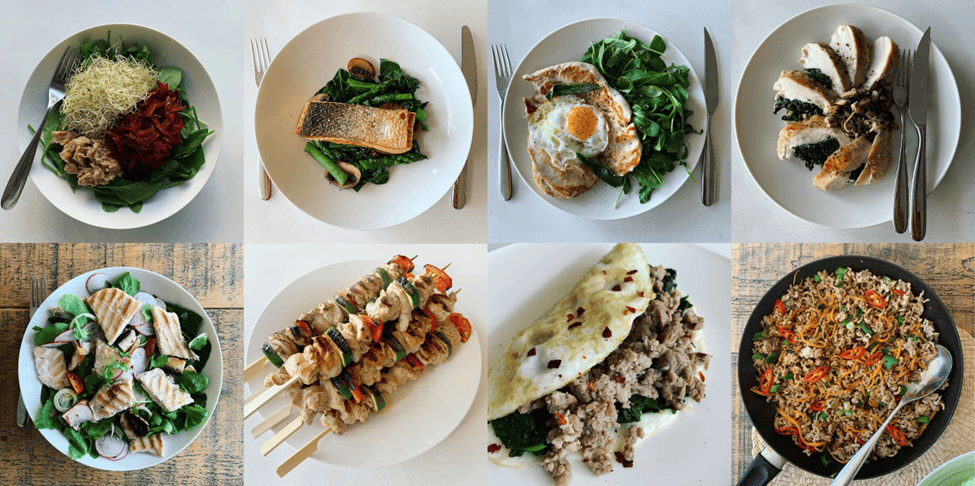
Why is Niacin Important?
- Energy production: Niacin helps convert food into energy by aiding in the breakdown of carbohydrates, fats, and proteins.
- Cardiovascular health: Niacin can help lower LDL (“bad”) cholesterol levels and raise HDL (“good”) cholesterol levels, reducing the risk of heart disease.
- Brain function: Niacin is essential for producing neurotransmitters, such as serotonin, which plays a crucial role in regulating mood, appetite, and sleep.
- Skin health: Niacin has been shown to improve skin health by reducing inflammation, preventing acne, and improving the skin’s natural barrier function.
- Digestive health: Niacin is important for properly functioning the digestive system and helps maintain healthy gut bacteria.
What Does Niacin Do in Your Body?
- Because niacin is critical for energy utilisation, it can help lower cholesterol, ease arthritis, and boost brain function.
- Niacin is a precursor of NAD and NADP. These two coenzymes are involved in over 400 crucial bodily reactions, including cellular metabolism and the movement and transfer of energy throughout the body.
- Niacin plays a role in cell signalling, or cell communication, to initiate essential processes.
- Niacin is also crucial for creating and repairing DNA.
- Niacin helps to inhibit the deposit of fatty acids into the liver and can be helpful in conditions like non-alcoholic fatty liver disease (NAFLD).
- Niacin works as an antioxidant and protects various parts of the body from oxidative damage.
If someone is not getting enough niacin from their diet, all these biological processes suffer.
You Can Make Niacin from Protein
Your body gets most of its niacin through food but can make small amounts endogenously from the amino acid tryptophan. However, this process isn’t overly reliable as a source of vitamin B3, though, as only around 2% of niacin is converted from tryptophan.
What Are the Symptoms of Vitamin B3 Deficiency?
The official name for niacin deficiency is pellagra, although it has become rare since the food fortification of vitamin B3 began. However, this vitamin deficiency can present itself if someone consumes a diet low in protein or niacin-rich foods.
Someone may also fall short of their niacin intake if there are absorption issues, like small intestine or stomach damage. Too much alcohol or conditions like irritable bowel syndrome (IBS) can contribute to poor niacin absorption in this way.
Symptoms of niacin deficiency include:
- pigmented brown rash or discolouration when exposed to sunlight (perhaps the most distinctive characteristic),
- bright red tongue,
- vomiting,
- dementia (memory loss and mental confusion),
- fatigue,
- depression,
- headache,
- anorexia,
- diarrhea, and
- dermatitis.
B vitamins are a ‘family’ and often reinforce and synergise one another’s actions. For this reason, inadequate riboflavin (B2) and pyridoxine (B6) intake can also contribute to a niacin deficiency. Likewise, inadequate intake of iron has a similar effect.
Niacin Storage in Your Body
Niacin is water-soluble, meaning your body doesn’t store it for long, so you must consume niacin-rich foods regularly. However, the fact that niacin is water-soluble means that your body can quickly excrete excess niacin.
Functions of Niacin
You require adequate niacin to:
- break down your food,
- build and grow your muscles,
- detoxify your body,
- create cholesterol and fats usable for the body,
- recycle other nutrients (e.g., vitamin K and folate),
- manage oxidative stress,
- use neurotransmitters in your brain,
- create and repair your DNA, and
- lengthen your telomeres (an indicator of aging and longevity).
NAD+
NAD+ is a critical enzyme that helps to shuttle electrons throughout your body. A decrease in your NAD+ levels is a crucial marker of aging and lower energy. Reduced NAD+ has also been linked to cardiovascular and renal disease.
The increase in NAD+ and sirtuins seems to be one of the reasons that calorie restriction and fasting help repair our bodies and delay the onset of aging. Hence, focusing on higher satiety nutrient-dense foods and meals rich in NAD+ precursors like niacin can help delay diseases of ageing.
Factors That Increase Your Demand for Niacin
The body varies in its demands for different nutrients depending on the environment it is exposed to. For example, if there are more stressors in your life, there may be a higher demand for niacin.
You may need more niacin if you:
- consume excessive amounts of alcohol,
- eat a lot of sugar,
- have diarrhoea,
- have a fever,
- have high cholesterol,
- are going through a growth spurt,
- consume a low-protein diet,
- eat a lot of refined foods,
- are a smoker,
- are more physically active,
- have schizophrenia or
- have ulcerative colitis.
Excess B3 Side Effects: The Niacin Flush
The Upper Limit Intake (UL) for niacin has been set at 35 mg/day because of the niacin flush response that can occur if taking large doses of supplemental niacin. This is harmless but slightly uncomfortable for some.
A bolus of supplemental niacin is absorbed more quickly than food, allowing large amounts to flood into the bloodstream. As a result, capillaries expand rapidly, allowing blood to flow to the skin’s surface. The flush is harmless, but it can be uncomfortable and surprising! It’s a bit like an internal sauna.
Although B3 is essential for energy production, high supplemental doses of B3 will slow lipolysis and gluconeogenesis because it sends a ‘full’ signal to the body. If you choose to supplement Vitamin B3, don’t take it right before a workout because it will limit your energy availability because your body won’t mobilise your stored body fat as readily. In addition, excessive supplemental niacin may cause insulin resistance and impaired glucose tolerance (i.e., diabetes).
If you choose to supplement with B3, start small at 25 mg/day and see what happens before ramping up to higher doses. Taking niacin in the middle or towards the end of a meal can help limit the flush by slowing adsorption rather than taking it on an empty stomach.
High-dose niacin supplementation for managing diabetes, high cholesterol, and other conditions should only be done under the supervision of an experienced health practitioner who can monitor changes in your cholesterol, insulin, and glucose levels over time.
Synergistic Nutrients with Niacin
Niacin works synergistically with vitamins B1, B2, B6, B12, C, chromium, zinc, potassium manganese, phosphorus, copper, folate, iron, magnesium, methionine, selenium, and tryptophan. Your body requires these other nutrients for niacin to function correctly.
While supplements may be convenient, they often do not come equipped with all of these vitamins and minerals as food does. Hence, getting your niacin from whole food sources that naturally are packaged with other synergistic nutrients is crucial.
Niacin Fortification – A Double-Edged Sword?
Widespread fortification of common foods with vitamin B3 was introduced in the 1930s to combat an outbreak of pellagra worldwide. However, deficiency in this nutrient was found to be more common in poorer areas, particularly during the Great Depression, when people could only afford to eat foods that lacked niacin, like rice, wheat, and corn.
Guidelines for fortification were revised in 1974, with a sharp increase in the fortification of common breakfast cereals. As shown in the chart below, created from data from the USDA Economic Research Service, the availability of niacin in the food system has increased with the fortification of breakfast cereals and bread.
Interestingly, our satiety analysis shows that very high levels of niacin correlate with a higher calorie intake. More niacin from supplements and fortification does not equate to greater satiety.
Many modern foods are heavily processed and contain excessive amounts of synthetic vitamins. In addition, processed foods are typically higher in fats and carbs and low in protein, making them easy to overeat and dense in calories.
The 2014 paper Excess vitamin intake: An unrecognised risk factor for obesity highlights that sharp increases in infant formula and breakfast cereal fortification were proportional to increases in obesity rates when introduced in different countries. The study also notes that B vitamins promote fat synthesis when taken in excess. In addition, they may cause hypoglycaemia (low blood sugars) and thus increase appetite for more high glycaemic foods when added to foods like fortified bread and cereals with a high glycaemic index.
Fortification and supplementation can benefit frank deficiencies or where nutrient-dense foods are hard to obtain. Fortification has been life-changing in parts of the world where dietary staples are corn, wheat, and unfortified rice. However, data analysis suggests that supplementation and fortification of isolated nutrients in levels over and above what is naturally found in whole foods do not correlate with an overall lowered calorie intake. Therefore, the satiety impact shown in this analysis can only be assumed for minimally processed foods that naturally contain these nutrients.
In 1959, the University of Illinois produced a landmark pamphlet titled “Balancing Swine Rations“, documenting their research that identified the feeding regime for pigs that optimised growth and minimised the amount of feed in the shortest amount of time. The most rapid weight gain was observed in pigs with only a fortified feed and no alternative.
Before the widespread fortification of pig feed, farmers knew that pigs housed in barns fed solely on grain and corn would get sick, lose their hair, and fail to thrive. As a result, the farmers needed to ensure that pigs had time on pasture or were fed alfalfa to obtain adequate vitamins to grow and remain healthy before vitamin fortification.
But this all changed once they optimised the fortification of their chow. They initially found that the pigs would predominantly choose the pasture and unfortified feed if given a choice, although they would not grow as fast. However, once given only fortified feed, they would eat more and lose interest in healthier natural foods.
In his book, The End of Craving, Mark Schatzker likens our modern food system to the fortified pig food designed to minimise input, prevent deficiencies and maximise growth.
Fortification of processed food appears to override our innate drive to seek out a variety of foods containing the full spectrum of nutrients we need to avoid excess calorie intake and thrive. Since the study was performed in 1959, this understanding of supplementation has been used heavily to maximise growth rates in livestock for meat production.
This understanding of the role of fortification also appears to have influenced human food. The increased rates of fortification in breakfast cereals and other ultra-processed ‘foods’ may have inadvertently had a similar impact. Because highly processed food now contains more of the narrow spectrum of nutrients required to thrive, we are more content to eat more of them. As a result, we have a reduced appetite for food naturally containing common nutrients.
If we have innate cravings for vitamins, fortification may increase cravings for processed and fortified foods and drown out cravings for whole foods containing other vital nutrients like amino acids, potassium, sodium and calcium needed to thrive.
In summary, it can only be assumed that the positive satiety impact of increased nutrient density comes from whole foods containing a complete range of essential and non-essential nutrients–not isolated synthetic nutrients!
While getting adequate niacin from natural sources (rather than supplements) is critical, you should also avoid getting excess niacin from processed foods to regulate appetite and cravings.
How Can I Calculate if I am Getting Enough Vitamin B3?
Incorporating a variety of B3 food sources in your diet can significantly contribute to meeting your daily niacin requirements.
Curious about your Vitamin B3 intake? Take our Free 7-Day Nutrient Clarity Challenge and discover if you’re hitting the Vitamin B3 sweet spot in your diet.
After just one week of tracking your daily meals with Cronometer, Nutrient Optimiser will unveil a personalised roadmap, your guide to a healthier, more nutrient-rich lifestyle.

You’ll receive a curated list of foods and tantalising NutriBooster recipes that not only fill your Vitamin B1 gaps but also ensure you’re not missing out on vital nutrients like selenium.
Ready to unlock your nutrient potential? Join the challenge and embark on a journey towards a brighter, healthier you!
Nutrient Density Starter Pack
Ready to supercharge your nutrition? Get our Nutrient Density Starter Pack – your all-access pass to a healthier, more vibrant you!
In our quest to make Nutritional Optimization a breeze, we’re thrilled to offer you this treasure trove of tools and resources when you join our vibrant Optimising Nutrition Community:
- Food Lists: Discover our carefully crafted lists optimised for each essential nutrient, tailored to your goals, preferences, and unique conditions.
- The Healthiest Meal Plan in the World: Peek into a week of mouthwatering, nutrient-dense meals that’ll leave you satisfied and energised.
- Recipes: Download delectable samples from our NutriBooster recipe books, designed to elevate your nutrition while tantalising your taste buds.
- 7-Day Nutrient Clarity Challenge: Unearth your priority nutrients and pinpoint the foods and meals that pack a nutrient punch so you can kickstart your journey to better health.
Don’t miss out on this incredible opportunity to transform your nutrition effortlessly. Join our community and unlock your path to a healthier, more vibrant you!”
Nutrient Series
Minerals
- Calcium
- Iron
- Magnesium
- Phosphorus
- Potassium
- Sodium
- Zinc
- Selenium
- Copper
- Manganese
- Chromium
- Molybdenum
- Biotin (B7)
- Iodine
Vitamins
- Vitamin A
- Vitamin E
- Thiamine (B1)
- Riboflavin (B2)
- Niacin (B3)
- Pantothenic acid (B5)
- Vitamin B6
- Folate (B9)
- Vitamin B12
- Vitamin C
- Vitamin D
- Choline
- Vitamin K1
- Vitamin K2

